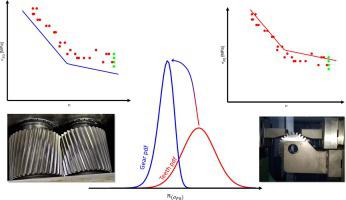International Journal of Fatigue ( IF 5.7 ) Pub Date : 2021-08-12 , DOI: 10.1016/j.ijfatigue.2021.106451 L. Bonaiti 1 , C. Gorla 1

|
Gear failure due to tooth root bending fatigue is one of the most dangerous gear failure modes. Therefore, the precise definition of gear bending fatigue strength is a key aspect in gear design. As a matter of fact, in order to assess a gear component, an accurate estimation of the component SN curve is required. This curve must properly take into account three main aspects: the slope of the fatigue strength region, the slope of the region ahead the fatigue knee and the position of the knee itself. In addition, with the aim of being able of considering different reliability levels, a proper estimation of the associated dispersion is required too.
Single Tooth Bending Fatigue (STBF) tests are usually used to investigate the tooth load carrying capacity with respect to the bending failure mode. However, due to the test rig configuration, two main differences between test and real case are present. Firstly, the statistical behavior is different, since in the meshing gear the strength is determined by its weakest tooth, while in a STBF test the failing tooth is predetermined. Secondly, the load history is different.Therefore, additional effects have to be taken into account to obtain the gear SN curve starting from STBF tests. In this article, due to its capability of handling interrupted tests (e.g. runouts), Maximum Likelihood Estimation (MLE) has been used to estimate, in the most reliable way, the SN curve from experimental points. SoE (Statistic of Extremes) has been adopted to move from the STBF SN curve to the gear one, as, by means of a simple mathematical passage, SoE enables the estimation of the strength of the weakest tooth among the z gear teeth and, as a consequence, of the gear. The effect of the different load history is considered by adopting a literature-based approach (i.e. use of corrective coefficient).
This paper describes in detail the proposed calculation method and shows its application to determine the SN curve in a practical case.
中文翻译:

最大似然法和极值统计估计齿轮齿根弯曲疲劳的SN曲线
由于齿根弯曲疲劳引起的齿轮失效是最危险的齿轮失效模式之一。因此,齿轮弯曲疲劳强度的精确定义是齿轮设计的一个关键方面。事实上,为了评估齿轮部件,需要对部件 SN 曲线进行准确估计。该曲线必须适当考虑三个主要方面:疲劳强度区域的斜率、疲劳膝部前方区域的斜率和膝部本身的位置。此外,为了能够考虑不同的可靠性水平,还需要对相关色散进行适当的估计。
单齿弯曲疲劳 (STBF) 测试通常用于研究与弯曲失效模式相关的齿承载能力。然而,由于测试台配置的原因,测试和真实案例之间存在两个主要差异。首先,统计行为是不同的,因为在啮合齿轮中,强度由其最弱的齿决定,而在 STBF 测试中,失效齿是预先确定的。其次,负载历史是不同的。因此,必须考虑额外的影响,以获得从 STBF 测试开始的齿轮 SN 曲线。在本文中,由于其处理中断测试(例如跳动)的能力,最大似然估计 (MLE) 已被用于以最可靠的方式估计实验点的 SN 曲线。z齿轮齿,因此,齿轮。通过采用基于文献的方法(即使用校正系数)来考虑不同负载历史的影响。
本文详细描述了所提出的计算方法,并展示了其在实际案例中确定 SN 曲线的应用。











































 京公网安备 11010802027423号
京公网安备 11010802027423号